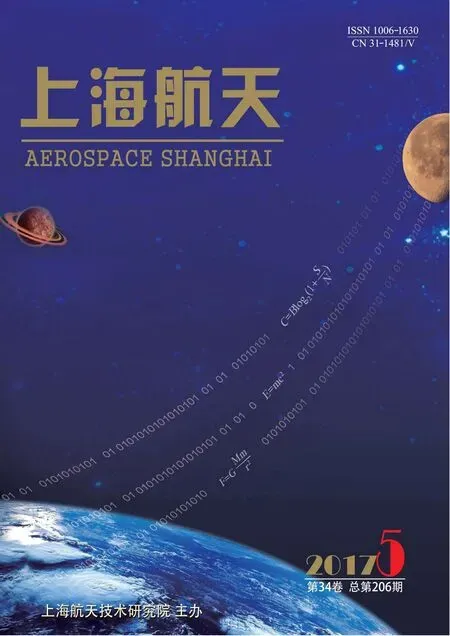自由漂浮柔性航天器的非線性擾動觀測器設計
孫凱鵬,廖 鶴,趙艷彬,陳 提,許域菲,畢振瀚
(1.上海衛星工程研究所,上海 201109;2.南京航空航天大學 機械結構力學及控制國家重點實驗室,江蘇 南京 210016)
自由漂浮柔性航天器的非線性擾動觀測器設計
孫凱鵬1,廖 鶴1,趙艷彬1,陳 提2,許域菲1,畢振瀚1
(1.上海衛星工程研究所,上海 201109;2.南京航空航天大學 機械結構力學及控制國家重點實驗室,江蘇 南京 210016)
為提高控制策略的效率,考慮航天器的平動和轉動與柔性附件的振動相互耦合作用,對一種用于估計柔性附件對自由漂浮航天器主體平動和姿態轉動影響的非線性擾動觀測器(NDO)設計進行了研究。將自由漂浮航天器簡化為自由運動的中心剛體柔性梁(FHB)系統,用浮動坐標系建立了系統的動力學模型,并用假設模態法對柔性附件進行離散以方便計算。將與不可觀測狀態相關的項作為等效擾動項,并假設其為慢變且有界,設計了擾動觀測器。因考慮了柔性附件對航天位姿的擾動,設計的擾動觀測器具漸近收斂性和魯棒性。構建了Lyapunov函數,從理論上證明了該觀測器的收斂性。用無外力輸入的自由運動和受迫運動兩個數值仿真算例驗證擾動觀測器的有效性,結果表明設計的擾動觀測器估值與真實值基本一致。研究為后續包含擾動補償的控制器設計奠定了基礎。
自由漂浮; 柔性航天器; 擾動觀測器; Lyapunov穩定性; 中心剛體; 柔性梁; 擾動估計; 漸近收斂
0 引言
現代航天工業對柔性航天器控制精度和魯棒性的要求越來越高,柔性航天器中柔性附件的振動與航天器的平動、姿態運動相互耦合[1-3]。柔性附件的存在會影響航天器定位及姿態指向精度。一種有效的方法是將柔性附件的影響作為對主體的擾動處理,并設計合理的擾動觀測器,用于在控制器設計中補償該部分擾動[4-5]。對非線性擾動觀測器進行了大量研究[6-10]。文獻[11]對可能存在的噪聲、未建模部分設計了擾動觀測器,并給出了行星著陸過程的控制器設計。文獻[12]設計了一種非線性擾動觀測器,并理論證明了該觀測器具半全局穩定特性。文獻[13]解決了針對非線性系統的未知外部擾動自適應補償問題,并針對不同情況理論證明了相應的收斂特性。在柔性航天器動力學與控制領域,擾動觀測器也得到了廣泛關注,如文獻[7]基于非線性擾動觀測器理念研究了帶柔性附件航天器的姿態控制問題;文獻[14]針對柔性航天器姿態機動設計了一種基于擾動觀測器的反饋線性化控制律。文獻[15]研究了柔性機械臂的擾動觀測與邊界控制問題。但上述研究只考慮了柔性航天器姿態運動中的擾動觀測器設計。實際上,在柔性航天器工作過程中,航天器的平動與附件的振蕩也相互耦合,在部分高精度航天任務中,必須考慮附件對航天器平動的影響。針對自由漂浮的柔性航天器,本文對一種考慮對航天器平動和姿態轉動影響的非線性擾動觀測器設計進行了研究,用浮動坐標系方法建立了自由漂浮柔性航天器的動力學方程,將與不可觀測狀態有關的項作為等效擾動項處理,設計擾動觀測器,并用Lyapunov方法理論證明其收斂性,由兩個數值仿真算例驗證了設計的擾動觀測器的有效性。
1 數學模型
自由漂浮柔性航天器模型在航天工業中得到廣泛應用,如圖1所示。該模型可合理地簡化為自由運動的中心剛體柔性梁(FHB)系統。設FHB系統運動速度慢且附件變形小,可用浮動坐標系方法對該系統進行建模。浮動坐標系的核心是將附件的小變形直接疊加到剛體運動上。為便于研究,用假設模態法對柔性附件進行離散。
忽略梁的軸向變形,建立慣性系O-XY和隨動坐標系o-xy。設中心剛體的位置矢量ro=[xoyo]T;中心剛體的姿態角為θ;梁上任一點的位置矢量為rA。此處:xo,yo分別為中心剛體質心在慣性系中的X、Y軸坐標。則FHB系統的動能和勢能可分別表示為
(1)

設僅梁的位置姿態可測、可控。則根據Lagrange方程可得系統的動力學方程為
(2)
式中:M,C分別為質量矩陣和阻尼矩陣;g(q)為剛度項,且g(q)=?V/?q=Kq;τ為廣義外力矢量,且
τi=[FxFyT00]T=[(τi1)T0]T

2 擾動觀測器設計
為便于設計觀測器,將式(2)改寫為以下形式
(3)
式中:M1,C1分別為剛體運動質量矩陣和阻尼矩陣;M4,C4,K4分別為彈性變形質量項、阻尼項和剛度項;M2,M3分別為剛體運動與彈性變形的耦合質量矩陣;C2,C3分別為剛體運動與彈性變形的耦合阻尼矩陣;X為由剛體位置和姿態決定的矢量。
分析式(3)中的第一部分方程
(4)
(5)

(6)
航天器附件尺度一般很大,頻率很低,因此假設等效擾動項d為慢變且有界。為估計系統式(6)中的d,構建擾動觀測器
(7)

(8)
定義de為擾動觀測誤差,則
(9)


(10)

證明:選擇Lyapunov函數

(11)
計算其導數
(12)
3 數值算例

算例1:設無外力輸入狀況下,給定初始旋轉角速度0.1 rad/s和梁末端初始變形0.1 m,使系統自由運動,計算所得擾動矢量的第一、第二、第三項分別如圖2~4所示。由圖2~4可知:擾動矢量三個方向的分量估值與真實值較吻合,誤差很小。
算例2:設三個控制輸入均為幅值0.01、圓頻率0.1的正弦信號,即Fx,Fy,T0均為0.01sin(0.1t),計算所得擾動矢量的第一、第二、第三項分別如圖5~7所示。由圖5~7可知:估值與真實值幾乎一致。
4 結束語
本文主要的研究對象是自由漂浮的帶柔性附件航天器。將柔性附件產生的動力學影響描述成對主體航天器的擾動處理,并針對該種擾動設計了一種非線性觀測器,并從理論上證明了觀測器的收斂性,兩個數值仿真計算結果表明:設計的擾動觀測器估值與真實值基本一致,為后續包含擾動補償的控制器設計奠定了基礎。與前人研究相比,本文考慮了柔性附件對航天位姿的擾動,設計的擾動觀測器具漸近收斂性,由此也有一定的魯棒性。后續研究可考慮將該擾動觀測器作為擾動補償用于控制器設計,補償航天器柔性附件對本體定位及姿態指向精度的影響。
[1] 黃文虎, 曹登慶, 韓增堯. 航天器動力學與控制的研究進展與展望[J]. 力學進展, 2012, 42(4): 367-394.
[2] 蔣建平, 李東旭. 帶太陽帆板航天器剛柔耦合動力學研究[J]. 航空學報, 2006, 27(3): 418-422.
[3] CHEN T, WEN H, HU H, et al. Output consensus and collision avoidance of a team of flexible spacecraft for on-orbit autonomous assembly[J]. Acta Astronautica, 2016, 121: 271-281.
[4] GUO L, CAO S. Anti-disturbance control theory for systems with multiple disturbances: a survey[J]. ISA Transactions, 2014, 53(4): 846-849.
[5] YANG H, LIU J. Distributed piezoelectric vibration control for a flexible-link manipulator based on an observer in the form of partial differential equations[J]. Journal of Sound and Vibration, 2016, 363: 77-96.
[6] ZHANG R, LI T, GUO L. Disturbance observer based control for flexible spacecraft with time-varying input delay[J]. Advances in Difference Equations, 2013, 2013(1): 1-12.
[7] LIU H, GUO L, ZHANG Y. An anti-disturbance PD control scheme for attitude control and stabilization of flexible spacecrafts[J]. Nonlinear Dynamics, 2012, 67(3): 2081-2088.
[8] CHEN W H. Disturbance observer based control for nonlinear systems[J]. IEEE/ASME Transactions on Mechatronics, 2004, 9(4): 706-710.
[9] CHEN W, YANG J, GUO L, et al. Disturbance-observer-based control and related methods: an overview[J]. IEEE Transactions on Industrial Electronics, 2016, 63(2): 1083-1095.
[10] 吳忠, 黃麗雅, 魏孔明, 等. 航天器姿態自抗擾控制[J]. 控制理論與應用, 2013, 30(12): 1617-1622.
[11] CANUTO E, MOLANO-JIMENEZ A, PEREZ-MONTENEGRO C. Disturbance rejection in space applications: problems and solutions[J]. Acta Astronautica, 2012, 72: 121-131.
[12] BACK J, SHIM H. Adding robustness to nominal output-feedback controllers for uncertain nonlinear systems: a nonlinear version of disturbance observer[J]. Automatica, 2008, 44(10): 2528-2537.
[13] NIKIFOROV V O. Nonlinear servocompensation of unknown external disturbances[J]. Automatica, 2001, 37(10): 1647-1653.
[14] WANG Z, WU Z. Nonlinear attitude control scheme with disturbance observer for flexible spacecrafts[J]. Nonlinear Dynamics, 2015, 81(1-2): 257-264.
[15] JIANG T, LIU J, HE W. Boundary control for a flexible manipulator based on infinite dimensional disturbance observer[J]. Journal of Sound and Vibration, 2015, 348: 1-14.
NonlinearDisturbanceObserverDesignforFree-FloatingFlexibleSpacecrafts
SUN Kai-peng1, LIAO He1, ZHAO Yan-bin1, CHEN Ti2, XU Yu-fei1, BI Zhen-han1
(1. Shanghai Institute of Satellite Engineering, Shanghai 201109, China; 2. State Key Laboratory of Mechanics and Control of Mechanical Structures, Nanjing University of Aeronautics and Astronautics, Nanjing 210016, Jiangsu, China)
To improve the control efficiency, the design of nonlinear disturbance observer (NDO) was studied to estimate the influence of the flexible appendage on the translational and rotational motions of the spacecraft’s main body for free-floating flexible spacecrafts with the coupling between the translational and rotational motion of the spacecraft and the vibration of the flexible appendage in this paper. The floating spacecraft was simplified as free hub beam (FHB). The dynamic equations of the system were established by floating coordinate system. The flexible appendage was discrete for computation convenience by assumed mode method. The all terms related with non-observed state were treated as the equivalent disturbance, and it was assumed that they were slow changed and bound constrained. The observer was designed, which had asymptotic convergence and robustness because the disturbance of the flexible appendage on the position and attitude of the spacecraft was in consideration. The Lyapunov function was given to prove the convergence of the observer designed theoretically. Two numerical simulations which were free motion without force input and forced motion were computed to verify the effectiveness of the observer designed. The results showed that the estimation by the observer designed was well agreed with the true value. The study is valuable for latter controller design including disturbance compensation.
free-floating; flexible spacecraft; disturbance observer; Lyapunov stability; hub; beam; disturbance estimation; asymptotic convergence
1006-1630(2017)05-0054-05
2016-11-10;
2017-02-20
國家自然科學基金資助(11602145);國家重點研發計劃專項資助(2016YFB0500801);上海市科學技術委員會啟明星計劃(B類)資助(16QB1403500)
孫凱鵬(1987—),男,博士,主要從事衛星總體與結構技術研究。
V448.2
A
10.19328/j.cnki.1006-1630.2017.05.008

